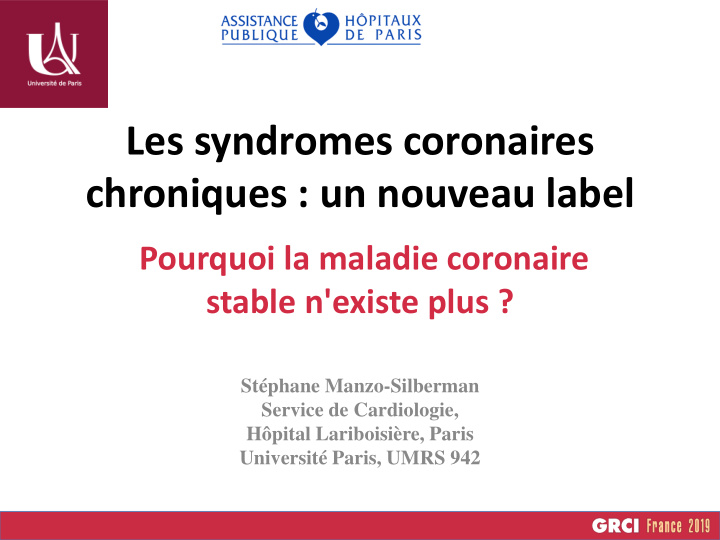



Les syndromes coronaires chroniques : un nouveau label Pourquoi la maladie coronaire stable n'existe plus ? Stéphane Manzo-Silberman Service de Cardiologie, Hôpital Lariboisière, Paris Université Paris, UMRS 942
D ÉCLARATION DE LIENS D’INTÉRÊT AVEC LA PRÉSENTATION Speaker ’ s name : Stéphane Manzo-Silberman • Pas de liens d’intérêts en relation avec la présentation
Definition or concept? CAD= pathological process, continuum Atherosclerotic accumulation Obstructive or non obstructive Active process: CV risk factors Can be modified: stabilized or decreased – Lifestyle modification – Pharmacological therapy – Invasive intervention Periods of unstability
Dynamic CAD CAD CCS ACS
CCS in 6 scenarii suspected CAD and ‘stable’ anginal symptoms, and/or dyspnoea CCV new onset of heart asymptomatic subjects failure (HF) or left in whom CAD is ventricular (LV) detected at screening dysfunction and suspected CAD asymptomatic and symptomatic patients angina and suspected with stabilized vasospastic or symptoms <1 year after microvascular disease an ACS, or patients with recent revascularization asymptomatic and symptomatic patients >1 year after initial diagnosis or revascularization
Suspected CAD and ‘stable’ anginal symptoms, and/or dyspnoea CCV
Suspected CAD and ‘ stable ’ anginal symptoms, and/or dyspnoea CCV
Suspected CAD and ‘stable’ anginal symptoms, and/or dyspnoea CCV
Suspected CAD and ‘ stable ’ anginal symptoms, and/or dyspnoea CCV Stable vs Unstable…. UNSTABLE ACS: – as rest angina >20 min – crescendo angina, i.e. previous angina, which progressively increases in severity and intensity, and at a lower threshold, over a short period of time. – new-onset angina <2 months onset of moderate-to-severe angina (Canadian Cardiovascular Society grade II or III ) CCS: new-onset angina with heavy exertion
Suspected CAD and ‘stable’ anginal symptoms, and/or dyspnoea CCV
New onset of heart failure (HF) or left ventricular (LV) dysfunction and suspected CAD HFpEF or HFrEF History Physical examination ECG Imaging: TTE Lab Management: – Pharmacological – Revascularization
Asymptomatic and symptomatic patients with stabilized symptoms <1 year after an ACS, or patients with recent revascularization Monitoring asymptomatic and symptomatic patients > 2 visits the 1 st year of Follow up with stabilized symptoms <1 year after an ACS, or patients with LV function 8-12 weeks after intervention recent revascularization Non invasive assessment of myocardial ischaemia
Asymptomatic and symptomatic patients >1 year after initial diagnosis or revascularization Assess patient’s risk Annual evaluation Lab tests: lipid profil, renal function, CBC +/- biomarkers: every 1 or 2 years Unexplained reduction systolic LV function->imaging Silent ischaemia: stress imaging
Angina and suspected vasospastic or microvascular disease Angina and NOCAD: increased risk Diagnosis impaired: – Stenoses with mild or moderate angiographic severity, or diffuse coronary narrowing, – Disorders affecting the microcirculatory domain – Dynamic stenoses of epicardial vessels caused by coronary spasm or intramyocardial bridges
Angina and suspected vasospastic or microvascular disease
Angina and suspected vasospastic or microvascular disease Microvascular dysfunction: – IMR ≥ 25 or CFR < 2.0 Vasospastic angina – Epicardial: Symptoms + ECG+ severe vasoconstriction – Microvascular spasm: Symptoms ± ECG+ 0 vasoconstriction CorMiCA: – 151 patients randomized: stratified medical treatment based on testing vs standard care – Testing: CFR, IMR, Acetylcholine testing1 year: significant difference in Angina scores
Asymptomatic subjects in whom CAD is detected at screening
Asymptomatic subjects in whom CAD is detected at screening: WOMEN Difference in symptoms Precise estimation of pretest probability Weakness of FRS, SCORE Implementation with: – Specific risks – Calcium score Stress TTE exercise or Dobutamine
Take Home Message CCS: different evolutionary phases of CAD, excluding situations in which an acute coronary artery thrombosis dominates the clinical presentation CCS: continuum of ischemic disease patterns from microvascular dysfunction to epicardial obstruction Step by step : – Pretest probability – Risk stratification – Diagnosis approach – Risk for future events
Merci de votre attention
Recommend
More recommend